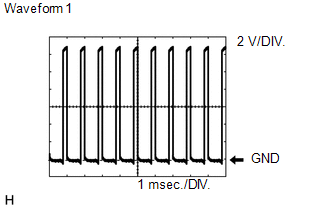Toyota Venza: Terminals Of Ecu
TERMINALS OF ECU
1. CHECK AWD CONTROL ECU

(a) Measure the voltage and resistance of the connector.
|
Terminal No. (Symbol) |
Terminal Description |
Condition |
Specified Condition |
|---|---|---|---|
|
14 (CANH) - 16 (CANL) |
CAN communication |
Ignition switch off |
54 to 69 Ω |
|
23 (GND) - Body ground |
Ground |
Always |
Below 1 Ω |
|
11 (IG1) - 23 (GND) |
Power source voltage |
Ignition switch ON |
10 to 14 V |
|
13 (SLC+) - 32 (SLC-) |
Electromagnetic solenoid signal |
D position, Idling |
Pulse generation (See waveform 1) |
|
9 (BSLC) - 23 (GND) |
Power source voltage |
Always |
10 to 14 V |
If the result is not as specified, the AWD control ECU may have a malfunction.
(b) Using an oscilloscope, check the waveform 1.
 Waveform 1 (Reference)
Waveform 1 (Reference)
|
Terminal Name |
Content |
|---|---|
|
Tester Range |
2 V/DIV., 1 msec./DIV. |
|
Condition |
D position, Idling |
 Test Mode Procedure
Test Mode Procedure
TEST MODE PROCEDURE
1. DESCRIPTION
HINT:
When using a chassis dynamometer, brake tester, etc. to perform a vehicle test,
activate test mode to avoid a "different tire diameter installed" ...
 Diagnosis System
Diagnosis System
DIAGNOSIS SYSTEM
1. DESCRIPTION
Active torque control 4WD system data can be read in the Data Link Connector
3 (DLC3) of the vehicle. When the system seems to be malfunctioning, use the Techstream ...
Other materials about Toyota Venza:
Diagnostic Trouble Code Chart
DIAGNOSTIC TROUBLE CODE CHART
Audio and Visual System
DTC Code
Detection Item
See page
B1532
LVDS Signal Malfunction (from Extension Module)
B1551
HD Radio ...
Registration
REGISTRATION
PROCEDURE
1. DESCRIPTION OF CODE REGISTRATION
HINT:
The ID codes are the same as recognition codes for the wireless transmitter
and the engine immobiliser function. Registering an ID code enables the
smart key system, the wirel ...
Installation
INSTALLATION
PROCEDURE
1. INSTALL FRONT DOOR FRONT WINDOW FRAME MOULDING
(a) Engage the front door front window frame moulding to the door frame.
(b) Using an air riveter or hand riveter with a nose ...
0.1554
